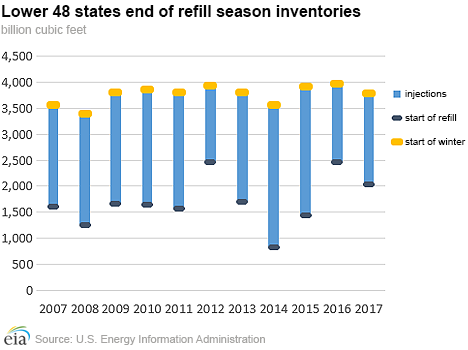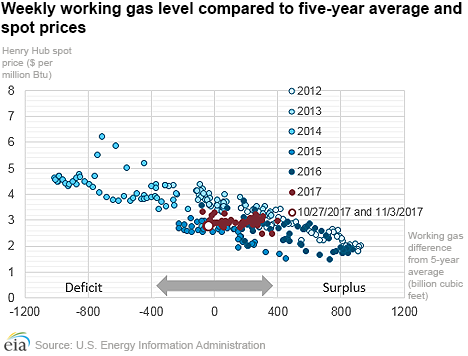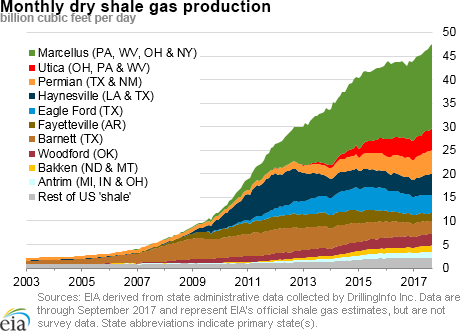In the News:
Natural gas stocks end refill season just below the five-year average
Working natural gas in storage in the Lower 48 states as of October 31 totaled 3,784 billion cubic feet (Bcf), as interpolated from EIA’s Weekly Natural Gas Storage Report data released November 9. The natural gas storage injection season has been traditionally defined as April 1 through October 31, although injections often occur into November. Inventories at the traditional end of this year’s injection season were 58 Bcf (2%) lower than the five-year (2012–16) end-of-October average and 193 Bcf (5%) lower than the record-setting level of 3,977 established last year.
Working gas stocks ended the withdrawal season this year at 2,036 Bcf on March 31—the third highest level ever reported, falling 425 Bcf below the record level of 2,461 Bcf reported at the end of March in 2016. From April 1 through October 31, EIA estimates that net injections this year totaled 1,754 Bcf and were 298 Bcf (15%) lower than the five-year average and 238 Bcf (16%) more than injections last year. This was the third-lowest net injected volume for the refill season since 2007, with net injections this year exceeding only the 2012 total of 1,456 Bcf and the 2016 total of 1,516 Bcf—the only years with working gas levels over 2,400 Bcf at the beginning of the refill season.
Injection levels during refill season level can vary considerably, depending in large part on inventory levels at the start of the refill season. In 2016 and 2012, a high April 1 starting point and stronger-than-average power sector consumption during the late-spring and summer contributed to lower-than-average weekly net injections. Similarly, this year, a high April 1 level also resulted in a slower-than-average pace of injections. However, in 2017, increased natural gas demand came from the export sector, offsetting year-over-year declines in domestic electric power sector consumption of natural gas. In the past three years, working gas stocks have ended October within 200 Bcf of the previous five-year average.
Working gas levels have fallen below the five-year average in recent weeks, which may suggest that the market is tightening. The slow pace of injections during the 2017 refill season resulted in the difference between the working gas and its five-year average declining from a surplus of 265 Bcf on March 31 to a deficit of 58 Bcf on October 31. Historically, working gas deficits to the five-year average are correlated with higher spot prices at the Henry Hub, and surpluses to the five-year average are correlated with lower spot prices. Persistent working gas deficits to the five-year average could contribute to higher prices if natural gas supplies from storage become significantly more constrained in meeting increases in natural gas demand.
Overview:
(For the Week Ending Wednesday, November 1, 2017)
- Natural gas spot prices rose at most locations this report week (Wednesday, November 1 to Wednesday, November 8). The Henry Hub spot price rose from $2.64/MMBtu last Wednesday to $3.15/MMBtu yesterday.
- At the New York Mercantile Exchange (Nymex), the December 2017 contract price rose 28¢ from $2.893/MMBtu last Wednesday to $3.175/MMBtu yesterday.
- Net injections to working gas totaled 15 Bcf for the week ending November 3. Working natural gas stocks are 3,790 Bcf, which is 5% less than the year-ago level and 2% lower than the five-year (2012–16) average for this week.
- The natural gas plant liquids composite price at Mont Belvieu, Texas, fell by 6¢, averaging $8.22/MMBtu for the week ending November 8. The price of propane, butane, and isobutane fell by 2%, 3%, and 3%, respectively. The price of natural gasoline and ethane rose by 3% and 1%, respectively.
- According to Baker Hughes, for the week ending Friday, November 3, the natural gas rig count decreased by 3 to 169. The number of oil-directed rigs fell by 8 to 729. The total rig count decreased by 11, and it now stands at 898.
Prices/Supply/Demand:
Prices rise this week on colder weather in the northern half of the country. This report week (Wednesday, November 1 to Wednesday, November 8), the Henry Hub spot price rose 51¢ from $2.64/MMBtu last Wednesday to $3.15/MMBtu yesterday. At the Chicago Citygate, prices increased 64¢ from $2.67/MMBtu last Wednesday to $3.31/MMBtu yesterday. Temperatures fell significantly in the northern half of the country late this report week, reaching into the Northeast. Some analysts noted that an anticipated cold snap today and tomorrow may have further pushed prices up.
Northeast prices up. Cold weather hit the Northeast late this report week, pushing prices up sharply. At the Algonquin Citygate, which serves Boston-area consumers, prices increased by $2.29, from $1.18/MMBtu last Wednesday to $3.47/MMBtu yesterday. At the Transcontinental Pipeline Zone 6 trading point for New York, prices increased $1.85 from $1.34/MMBtu last Wednesday to $3.19/MMBtu yesterday.
Tennessee Zone 4 Marcellus spot prices increased $1.71 from $0.52/MMBtu last Wednesday to $2.23/MMBtu yesterday. Prices at Dominion South in northwest Pennsylvania rose $1.91 from $0.67/MMBtu last Wednesday to $2.58/MMBtu yesterday.
Marcellus prices likely increased this week as a result of a combination of cold weather in the Northeast and the commencement of service of the Access South and Adair Southwest pipelines. These pipelines add approximately 0.6 Bcf/d takeaway capacity for the region and should help mitigate the regional discount. Several other infrastructure projects for the region are slated for commencement in early 2018, including the Rover Pipeline, the Nexus Gas Transmission Project, and the recently delayed Leach Xpress Project.
California prices mixed. Prices at PG&E Citygate in Northern California rose 34¢, up from $2.95/MMBtu last Wednesday to $3.29/MMBtu yesterday. The price at SoCal Citygate increased $1.18 from $3.23/MMBtu last Wednesday to $4.41/MMBtu yesterday. The Southern California Gas Company still faces constraints on inflowing pipelines and reduced storage availability from the Aliso Canyon facility. On November 2, the California Public Utilities Commission designated the storage field as an “asset of last resort” to be used for withdrawal only under certain conditions.
Supply flat. According to data from PointLogic Energy, the average total supply of natural gas remained the same as the previous report week, averaging 81.3 Bcf/d. Dry natural gas production remained constant week over week. Average net imports from Canada decreased by 5% from last week.
Overall demand up. Total U.S. consumption of natural gas rose by 2% compared with the previous report week, according to data from PointLogic Energy. Despite the relatively cold weather in the North, parts of the Gulf Coast experienced temperatures averaging in the high 70 degree Fahrenheit range. As a result, natural gas consumed for power generation climbed by 7% week over week. Industrial sector consumption decreased by 2% week over week. With warm weather in the South offsetting cold weather in the north, consumption in the residential and commercial sectors remained flat, averaging 21.7 Bcf/d. Natural gas exports to Mexico increased 4%.
U.S. LNG exports decrease week-over-week. Four LNG vessels (LNG-carrying capacity 14.4 Bcf) departed Sabine Pass liquefaction facility last week (Thursday to Wednesday) and one tanker (LNG-carrying capacity 3.8 Bcf) was loading at the terminal on Wednesday.
Storage:
Working gas deficit to five-year average grows to largest level since January 2017. Net injections into storage totaled 15 Bcf for the week ending November 3, compared with the five-year (2012–16) average net injection of 45 Bcf and last year's net injections of 54 Bcf during the same week. Working gas stocks total 3,790 Bcf, which is 71 Bcf less than the five-year average and 219 Bcf less than last year at this time. This is the largest that the deficit to the five-year average has been since it totaled 77 Bcf for the report week ending January 13, 2017. However, most of this deficit to the five-year average occurred in the South Central region, where working gas stocks fell to 42 Bcf below the five-year average level. Working gas levels in the East and Midwest regions—where natural gas is an important fuel for space and water heating—were 1 Bcf below and 15 Bcf above the five-year average, respectively.
Net injections fall below the five-year average in most regions. The East region reported its first withdrawal of the heating season, pulling 1 Bcf of natural gas from storage. The Midwest region posted net injections totaling 5 Bcf, or 8 Bcf below the five-year average. Net injections fell 7 Bcf below the five-year average of 20 Bcf in the South Central region for the report week. However, salt dome facilities posted net injections totaling 12 Bcf compared with the five-year average of 9 Bcf. The South Central salt region the only region to top the five-year average this week.
The January 2018 futures price trades at a premium compared with the current spot price. During the most recent storage week, the average natural gas spot price at the Henry Hub was $2.75/MMBtu, while the Nymex futures price of natural gas for delivery in January 2018 averaged $3.06/MMBtu, a difference of 31¢. The premium was 56¢ a year ago. The average natural gas spot price at the Henry Hub also was 14¢ lower than the front-month futures price at the Nymex. A year ago, the spot price was 33¢ lower than the front-month contract.
The reported net implied flows into storage are close to analysts’ expectations. According to the Desk survey of natural gas analysts, estimates of net injections into working natural gas storage ranged from 6 Bcf to 23 Bcf with a median of 14 Bcf. Prices for the futures contract for December delivery fell about 1¢/MMBtu to $3.20/MMBtu with 528 contracts traded at the release of the Weekly Natural Gas Storage Report (WNGSR). Prices remained close to that level in subsequent trading.
Temperatures decline on the week and are lower than normal in most regions outside the Northeast. Temperatures in the Lower 48 states averaged 50 degrees Fahrenheit (°F), 1°F lower than the normal and 7°F lower than last year at this time. During the prior report week ending October 26, temperatures averaged 59°F. Temperatures in the New England and Middle Atlantic Census divisions averaged 60°F and 58°F, or 11°F and 9°F above normal, respectively.
See also:
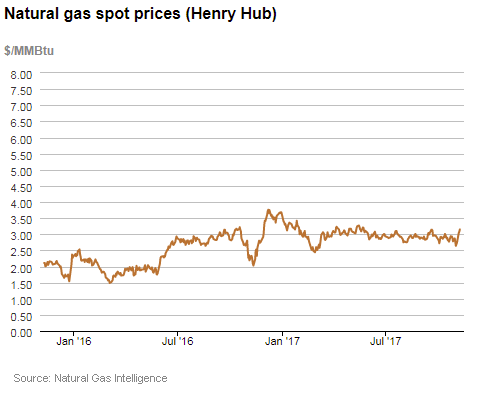
| Spot Prices ($/MMBtu) | Thu, 02-Nov |
Fri, 03-Nov |
Mon, 06-Nov |
Tue, 07-Nov |
Wed, 08-Nov |
|---|---|---|---|---|---|
| Henry Hub |
2.69 |
2.74 |
3.03 |
3.08 |
3.15 |
| New York |
1.99 |
1.49 |
3.03 |
3.08 |
3.19 |
| Chicago |
2.77 |
2.83 |
3.05 |
3.08 |
3.31 |
| Cal. Comp. Avg.* |
2.80 |
2.85 |
3.10 |
3.09 |
3.17 |
| Futures ($/MMBtu) | |||||
| December Contract | 2.935 |
2.984 |
3.134 |
3.152 |
3.175 |
| January Contract |
3.051 |
3.097 |
3.232 |
3.251 |
3.272 |
| *Avg. of NGI's reported prices for: Malin, PG&E Citygate, and Southern California Border Avg. | |||||
| Source: NGI's Daily Gas Price Index | |||||
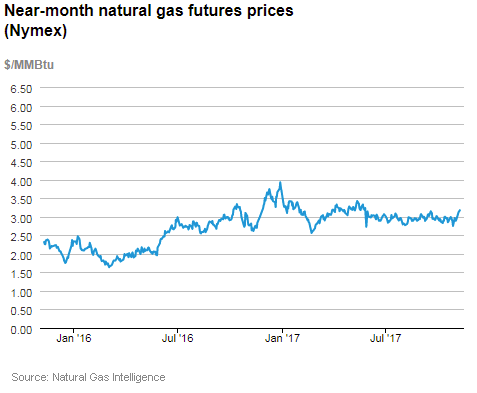
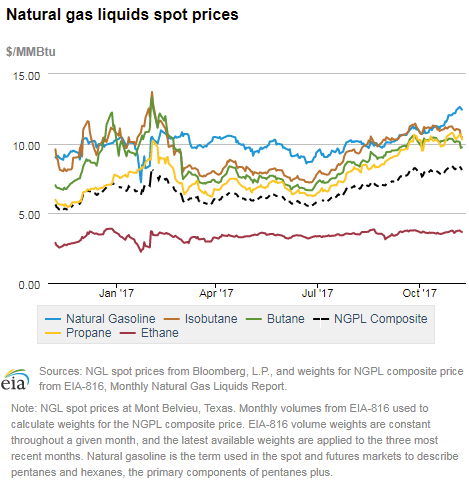
| U.S. natural gas supply - Gas Week: (11/2/17 - 11/8/17) | |||
|---|---|---|---|
Average daily values (Bcf/d): |
|||
this week |
last week |
last year |
|
| Marketed production | 84.0 |
84.2 |
78.4 |
| Dry production | 75.6 |
75.5 |
70.2 |
| Net Canada imports | 5.5 |
5.8 |
5.1 |
| LNG pipeline deliveries | 0.2 |
0.1 |
0.3 |
| Total supply | 81.3 |
81.4 |
75.6 |
|
Source: OPIS PointLogic Energy, an IHS Company | |||
| U.S. natural gas consumption - Gas Week: (11/2/17 - 11/8/17) | |||
|---|---|---|---|
Average daily values (Bcf/d): |
|||
this week |
last week |
last year |
|
| U.S. consumption | 65.9 |
64.7 |
59.3 |
| Power | 23.4 |
21.9 |
23.1 |
| Industrial | 20.8 |
21.2 |
20.2 |
| Residential/commercial | 21.7 |
21.7 |
16.1 |
| Mexico exports | 4.4 |
4.3 |
4.0 |
| Pipeline fuel use/losses | 6.2 |
7.0 |
5.6 |
| LNG pipeline receipts | 2.9 |
2.8 |
1.5 |
| Total demand | 79.4 |
78.8 |
70.4 |
|
Source: OPIS PointLogic Energy, an IHS Company | |||
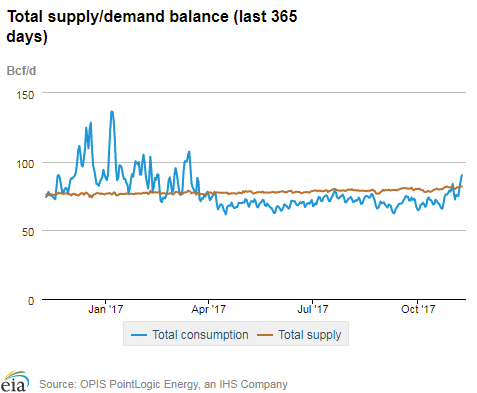
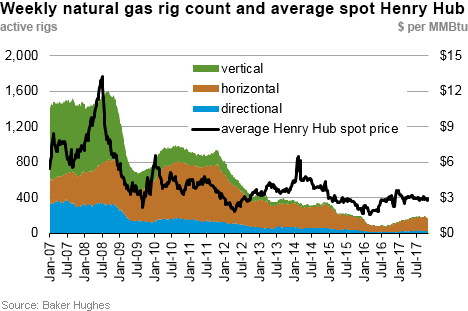
| Rigs | |||
|---|---|---|---|
Fri, November 03, 2017 |
Change from |
||
last week |
last year |
||
| Oil rigs | 729 |
-1.1% |
62.0% |
| Natural gas rigs | 169 |
-1.7% |
44.4% |
| Note: Excludes any miscellaneous rigs | |||
| Rig numbers by type | |||
|---|---|---|---|
Fri, November 03, 2017 |
Change from |
||
last week |
last year |
||
| Vertical | 61 |
-7.6% |
5.2% |
| Horizontal | 764 |
-0.7% |
66.4% |
| Directional | 73 |
-1.4% |
40.4% |
| Source: Baker Hughes Inc. | |||
| Working gas in underground storage | ||||
|---|---|---|---|---|
Stocks billion cubic feet (Bcf) |
||||
| Region | 2017-11-03 |
2017-10-27 |
change |
|
| East | 925 |
926 |
-1 |
|
| Midwest | 1,112 |
1,107 |
5 |
|
| Mountain | 224 |
226 |
-2 |
|
| Pacific | 317 |
317 |
0 |
|
| South Central | 1,212 |
1,199 |
13 |
|
| Total | 3,790 |
3,775 |
15 |
|
| Source: U.S. Energy Information Administration | ||||
| Working gas in underground storage | |||||
|---|---|---|---|---|---|
Historical comparisons |
|||||
Year ago (11/3/16) |
5-year average (2012-2016) |
||||
| Region | Stocks (Bcf) |
% change |
Stocks (Bcf) |
% change |
|
| East | 945 |
-2.1 |
926 |
-0.1 |
|
| Midwest | 1,145 |
-2.9 |
1,097 |
1.4 |
|
| Mountain | 252 |
-11.1 |
220 |
1.8 |
|
| Pacific | 327 |
-3.1 |
363 |
-12.7 |
|
| South Central | 1,339 |
-9.5 |
1,254 |
-3.3 |
|
| Total | 4,009 |
-5.5 |
3,861 |
-1.8 |
|
| Source: U.S. Energy Information Administration | |||||
| Temperature – heating & cooling degree days (week ending Nov 02) | ||||||||
|---|---|---|---|---|---|---|---|---|
HDD deviation from: |
CDD deviation from: |
|||||||
| Region | HDD Current |
normal |
last year |
CDD Current |
normal |
last year |
||
| New England | 88 |
-42 |
-56 |
0 |
0 |
0 |
||
| Middle Atlantic | 97 |
-24 |
-26 |
0 |
0 |
0 |
||
| E N Central | 164 |
31 |
74 |
0 |
-1 |
0 |
||
| W N Central | 193 |
55 |
125 |
0 |
-1 |
-3 |
||
| South Atlantic | 74 |
1 |
30 |
8 |
-9 |
-18 |
||
| E S Central | 96 |
21 |
79 |
2 |
-1 |
-16 |
||
| W S Central | 63 |
24 |
61 |
11 |
-5 |
-37 |
||
| Mountain | 110 |
-17 |
56 |
9 |
4 |
-8 |
||
| Pacific | 37 |
-19 |
1 |
6 |
4 |
6 |
||
| United States | 106 |
6 |
40 |
4 |
-2 |
-8 |
||
|
Note: HDD = heating degree day; CDD = cooling degree day Source: National Oceanic and Atmospheric Administration | ||||||||
Average temperature (°F)
7-Day Mean ending Nov 02, 2017
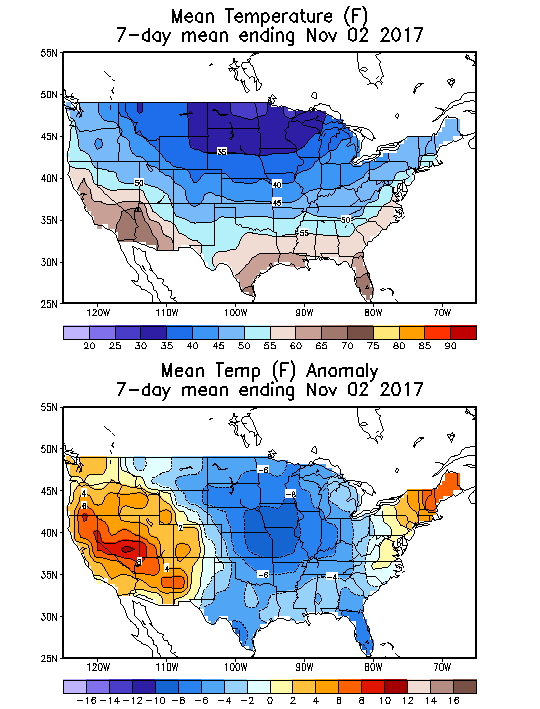
Source: NOAA National Weather Service
Deviation between average and normal (°F)
7-Day Mean ending Nov 02, 2017

Source: NOAA National Weather Service

